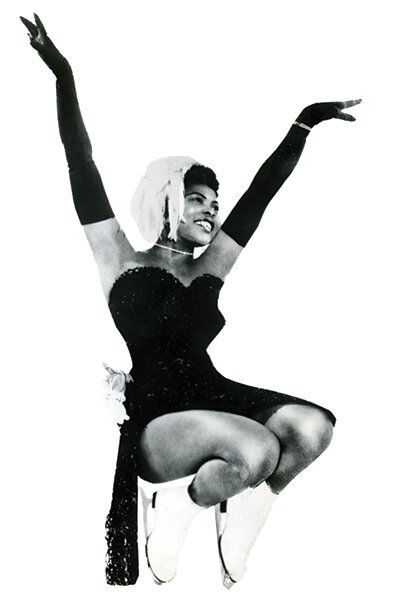 Figure skating was Mabel Fairbanks’ passion
. As a child she dreamed of becoming an Olympic champion, but one thing stood in her way — the color of her skin.
Figure skating was Mabel Fairbanks’ passion
. As a child she dreamed of becoming an Olympic champion, but one thing stood in her way — the color of her skin.
Born in the Florida Everglades, Fairbanks moved to New York City as a child. At age 10, her parents bought her first skates from a local pawnshop. Though they were two sizes too big, Fairbanks was undaunted. She began teaching herself to skate on a small ice surface in Harlem.
Refused admittance into the local skating rink because of her skin tone, Fairbanks persisted. When a sympathetic rink manager finally let her in, Fairbanks listened as coaches instructed their white students and learned all the tricks by watching what the other skaters were doing.
Moving to Los Angeles in the 1940s, Fairbanks toured with Rhapsody on Ice and Ice Capades, eventually joining Ice Follies. She hit the Las Vegas show scene, garnering a circle of friends that included Frank Sinatra, Dean Martin, Cary Grant and Zsa Zsa Gabor.
In the early 1950s Fairbanks retired and returned to Los Angeles to coach. Atoy Wilson, who won the 1966 U.S. novice men’s title and became the first African- American to stand atop a national podium, recalled his coach with fondness. “Mabel had the unique ability to transmit that ‘it’ quality,” he said. “She was able to transmit her love of figure skating to her students. We spent hours on the ice but it was more than that. She taught us to have certain ideals about ourselves, that we should have an upscale character.
Wilson, who remained close to Fairbanks throughout the ensuing decades, said he learned a lot from her. “She was smart, and cunning in the sense that she could see through things and get to the essence. It was remarkable to be around that quality of person.”
In 1968 Fairbanks paired Tai Babilonia and Randy Gardner for a club show at the All Year Figure Skating Club. She had to bribe them with candy to get them to hold hands. “We didn’t know what she saw but we held hands and did it,” Babilonia recalled. “It changed the whole dynamic of our lives and our families’ lives.”
Eleven years later Babilonia and Gardner won the World title.
Fairbanks herself knew no color boundaries Babilonia said. “It didn’t matter to her what color or ethnicity you were, whether you had money or not. The big stars sent their children to her for lessons — Dean Martin, Nat King Cole and Danny Kaye — and we were all in the same boat. If our parents couldn’t bring us to the rink, she would pick us up in her Cougar and we would all pile in.”
Wilson and Babilonia both remember Fairbanks as a vibrant and eclectic woman who set trends “who was so ahead of her time and so hip.”
“She had orange, red, purple and gold skates,” Wilson recalled, adding “she was very daring. She would change her hair from pink to orange to red. She was very flamboyant but with grace and elegance.”
Over the decades Fairbanks coached some of America’s top talents in their early careers including Scott Hamilton, Tiffany Chin, Debi Thomas, Kristi Yamaguchi and Rudy Galindo.
Fairbanks was inducted into the U.S. Figure Skating Hall of Fame in 1997. In September 2001 she died from myasthenia gravis, a muscular degenerative disease.
“She had a great personality and there was a special quality to her that is indescribable,” Wilson said. “She changed people’s lives, and she excelled with minority kids.”
Babilonia said she thinks about Fairbanks every day. “If it weren’t for her, we wouldn’t have this wonderful life. Without Mabel there would never have been Tai and Randy. She was the one who opened the door — that big colorful door.”
(This article was originally published in the IFS December 2008 issue)
TAI BABILONIA SERIES:
In Living Color: Atoy Wilson